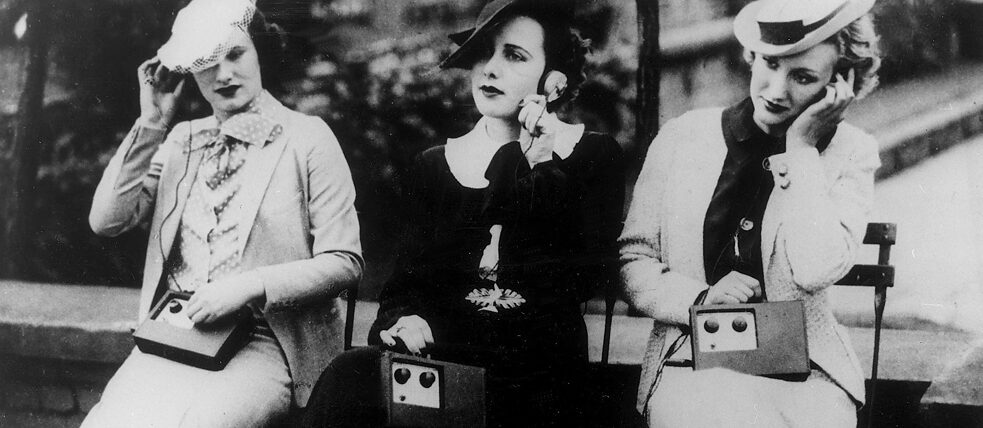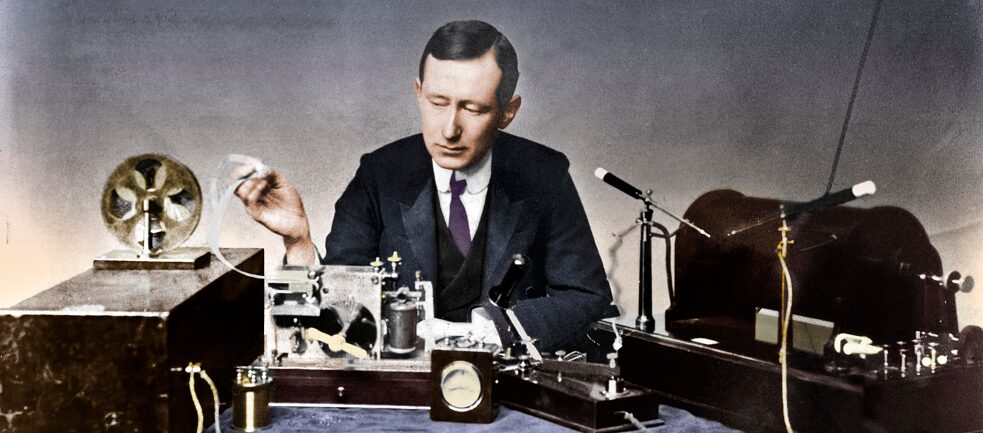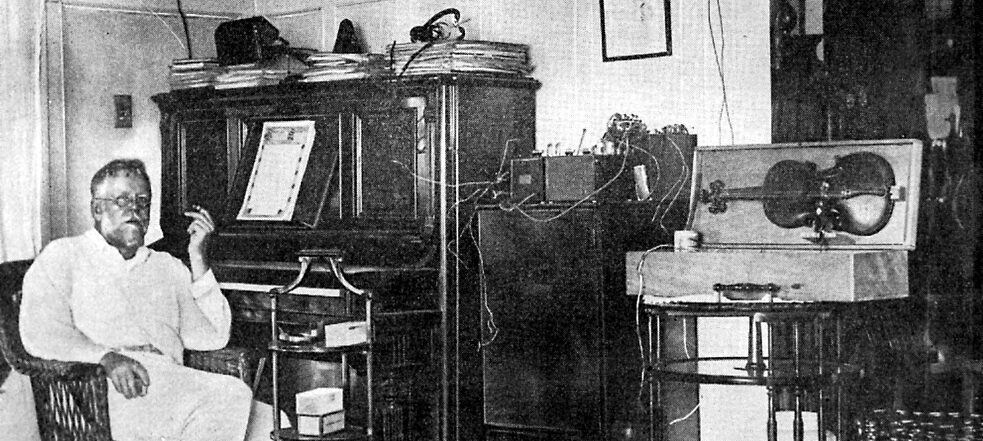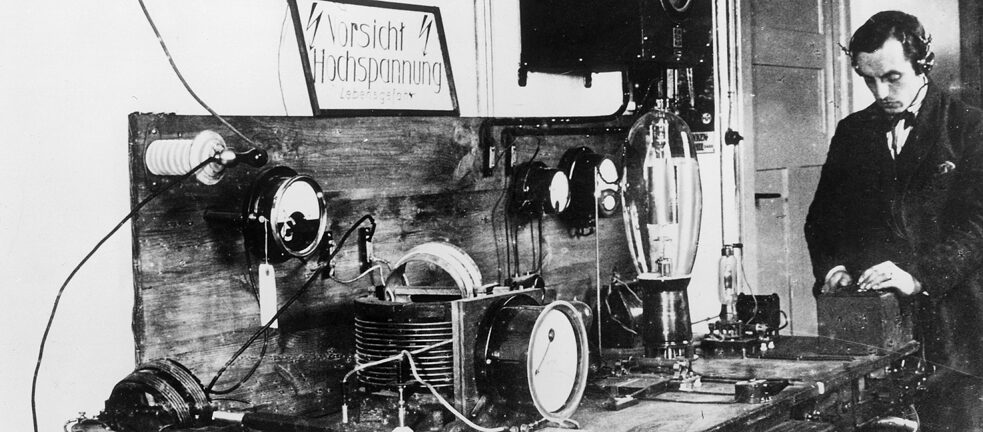The Early Days of Radio
“Attention, Attention”

It is more than 100 years since the radio began to conquer the world. We have listened to the first sentences transmitted by wireless telegraphy: a journey back in time to the earliest beginnings of radio technology and radio entertainment.
On 29 October 1923, at precisely 8 pm, the first official German radio station went on air. “Funk-Stunde Berlin” began transmitting from the office of a record company in Potsdamer Strasse. The first sentences to be broadcast were as follows: “Attention, attention, here is the transmitting station at Vox House on 400-metre wave radio. Ladies and gentlemen, we hereby inform you that today the radio entertainment service begins with the transmission of musical performances via wireless telephone channels.” This was followed by a piece for cello and piano that was performed live in the studio.
In 2023 we are celebrating the 100th anniversary of the first broadcaster of radio entertainment in Germany. But how did the history of long-distance radio broadcasting worldwide begin? Which legendary first words were transmitted through the ether elsewhere?
“Can You Hear Me?”
As early as 1895, the Italian engineer Guglielmo Marconi was the first to successfully transmit sound wirelessly over a distance of 1.5 kilometres. From a beach in Wales, he transmitted the words “Can you hear me?” to his assistant George Kemp, who replied: “Yes, loud and clear”.
This conversation was conducted in Morse code, however, as the means necessary to transmit language had yet to be developed. Marconi was also not the only one to be exploring the new transmission technologies. The physicist James Clerk Maxwell laid the foundation with his theories about radio waves, and Heinrich Hertz, likewise a physicist, was able to confirm them. The physicists and electrical engineers Nikola Tesla, Ferdinand Braun and Alexander Stepanovich Popov were also among the pioneers of radio technology.
 In 1902, the Italian engineer Guglielmo Marconi attempted the first transatlantic radio transmission of – Morse codes! Marconi is pictured with a radio transmitter and Morse keyer (undated photo).
| Foto (Detail): © picture alliance/Heritage Images
In 1902, the Italian engineer Guglielmo Marconi attempted the first transatlantic radio transmission of – Morse codes! Marconi is pictured with a radio transmitter and Morse keyer (undated photo).
| Foto (Detail): © picture alliance/Heritage Images
“One, Two, Three, Four. Is It Snowing Where You Are, Mr Thiessen?”
In the end, it was Reginald Fessenden who took the crucial step in developing the radio. The Canadian inventor was the first to transmit speech via wireless telegraphy. In Maryland on 23 December 1900, he addressed his assistant Mr Thiessen, who was approximately 1.5 kilometres away. He said: “One, two, three, four. Is it snowing where you are, Mr. Thiessen? If it is, telegraph back and let me know.”Mr Thiessen telegraphed back, and yes, it was snowing.
“Glory to God in the Highest”
Six years later, Reginald Fessenden even managed another pioneering achievement. He broadcast what is thought to be the world’s first broadcast of radio entertainment comprising a mixture of music and words that he had put together himself. On Christmas Day evening in 1906, in a radio station in Brant Rock in Massachusetts, he held his microphone next to a gramophone and transmitted a recording of Georg Friedrich Handel via voice radio. He then picked up a violin himself and played Silent Night. He concluded his programme with a verse from the Bible: “Glory to God in the highest, and on earth peace to men of good will”.His broadcast, which was addressed especially to seamen and sailors, was received as far away as the Caribbean Sea. To this day it is seen as the beginning of a new era – and to some extent also as the birth of the DJ, the presenter and the violin-playing master of ceremonies.
 The violin-playing radio host is born: with his violin, Reginald Fessenden presented what is thought to be the first entertainment programme in the history of radio on Christmas Day evening 1906 (undated photo).
| Foto (Detail): © picture alliance /Associated Press
The violin-playing radio host is born: with his violin, Reginald Fessenden presented what is thought to be the first entertainment programme in the history of radio on Christmas Day evening 1906 (undated photo).
| Foto (Detail): © picture alliance /Associated Press
“Hello, This Is Königs Wusterhausen“
An experiment was also conducted in Germany at Christmas. In December 1920, around 120 people are reported to have listened to a test transmission. Post office engineers welcomed the audience with the words: “Hallo, hier Königs Wusterhausen auf Welle 2700. Meine Damen und Herren, zum Zeichen, dass unsere Station jetzt großjährig geworden ist, wollen wir Ihnen ein kleines bescheidenes Weihnachtskonzert senden” (“Hello, this is Königs Wusterhausen on wave 2700. Ladies and gentlemen, as a sign that our station has now come of age, we wish to broadcast a small and modest Christmas concert to you”), and then, on musical instruments they had brought with them, likewise performed the Christmas carol Silent Night.“If This Light Is On – Keep Your Trap Shut!”
The first regular radio broadcast was launched on 6 November 1919 in the Netherlands. In Scheveningen, Hanso Schotanus à Steringa Idzerda would always go on air at night. He broadcast a programme that he financed out of his own pocket, featuring the grenadier march Turf in je ransel, meaning Peat in Your Haversack.Although Idzerda was able to extend his range every day, and at times could even be heard in England, the costs eventually exceeded his budget and he was forced to abandon his project a few years later. Incidentally, Idzerda is attributed with inventing the red lamp that always lights up when the microphone is switched on. In his case it was an illuminated board that proclaimed: “Brandt dit licht, dan koppen dicht!” (“If this light is on, keep your trap shut!”)
“The World’s First Commercial Radio Station”
The world’s first commercial radio station was finally established in the USA. On 2 November 1920, KDKA went on air in Pittsburgh with the following words: “This is KDKA Pittsburgh, the world’s first commercial radio station”. Unfortunately, it is no longer possible to tell whether the station also played the greatest hits of the 1880s, the 1890s and the top tunes of the day...“London Calling”
A short time later, the BBC – the British Broadcasting Company – began broadcasting in London. The idea originated from six manufacturers of electrical equipment who wanted to boost sales of their radio devices. The consortium put its plan into practice on 14 November 1922, launching Britain’s first radio station with the words: “2LO, Marconi House, London calling”. Rather than alluding to one of the biggest hits by the band The Clash, the presenter was in fact referring to the station’s identification number at the time and to the broadcasting location: a factory in London belonging to the aforementioned inventor and engineer Guglielmo Marconi.Incidentally, Marconi was also involved in the first radio station in his home country of Italy, where it took until 6 October 1924 before the opera singer Ines Viviani Donarelli welcomed listeners and announced a live broadcast of a Haydn concert in which she performed herself.
Today, the BBC is the world’s oldest national broadcasting company.
“Military Post Eiffel Tower”
In France, the Eiffel Tower in Paris – how could it have been anything else – was used as the first broadcasting site. After a number of tests involving Morse code and military music, the first words that were transmitted were somewhat banal: “Allô, allô, ici poste militaire de la Tour Eiffel“ (“Hello, hello, here is the military post Eiffel Tower”). From Christmas 1921, Radio Tour Eiffel broadcast a programme of entertainment comprising music, weather forecasts and some colourful features.And this is how radio programmes gradually evolved on all continents and in virtually all countries. To this day, the majority still broadcast a programme of entertainment comprising music, weather forecasts and some colourful features.
 „Achtung, Achtung“: Blick in die Sendestelle im Vox-Haus in Berlin, den Senderaum des ersten Berliner Rundfunksenders 1923.
| Foto (Detail): © picture alliance/ullstein bild
„Achtung, Achtung“: Blick in die Sendestelle im Vox-Haus in Berlin, den Senderaum des ersten Berliner Rundfunksenders 1923.
| Foto (Detail): © picture alliance/ullstein bild
350 Billion Marks
What has changed most of all over the past 100 years are the technical possibilities, which have assumed previously unimaginable dimensions: from the invention of the transistor radio to the internet and the smartphone. Nowadays, radio is transmitted in many different ways, and is far more than wireless telegraphy. Among other things, this has also had an impact on the Eiffel Tower – following the installation of a new antenna for digital radio transmission in 2022, it has increased in height by another six metres.One thing has remained the same, however: it costs money to listen to the radio. Anyone wishing to listen live to Germany’s first entertainment radio broadcast from Berlin on 29.10.1923 needed permission from the post office. A licence had to be purchased, which at that time of soaring inflation cost as much as 350 billion marks. By comparison, today’s monthly licence fee of 18.36 euros in Germany is a real bargain.